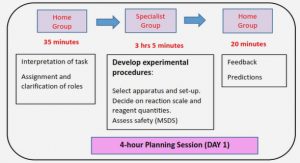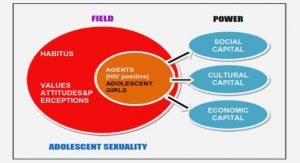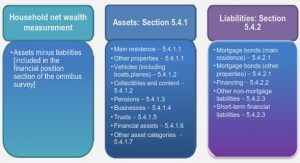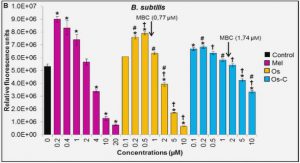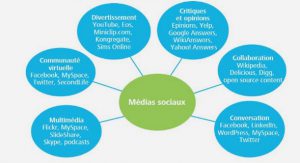Get Complete Project Material File(s) Now! »
RESEARCH METHODOLOGY
INTRODUCTION
This chapter describes the methodology used for this thesis. The chapter includes a description of the research design, data collection and data analysis. Finally, the chapter ends with a discussion on the validity and reliability of the thesis.
RESEARCH PROCESS
When conducting a research study, it is essential to follow a clear and structured research process (Yin, 2018). The research process (see Figure 1) for this thesis started by selecting a research topic before an initial literature review on the chosen topic. According to Karlsson (2009), an initial literature search can provide an overlook of existing literature which is beneficial for defining the research objective. The initial literature search resulted in an overview of what is already known within the selected research area as well as research gaps. As a result, a problem definition for this thesis could be defined, enabling the formulation of the thesis purpose and three research questions.
CASE STUDY METHOD
The purpose of this thesis is to propose a framework achieving for data-driven decision making in production development in the context of Industry 4.0. In order to fulfill the purpose of this thesis an appropriate research method is required. When selecting the research method, three conditions should be considered. The first condition relates to the formulation of the research questions (Yin, 2018). This thesis includes exploratory research questions, which according to Yin (2018) both can be answered by using a case study. The second condition is related to whether the research study focuses on contemporary events, which is the opposite of historical events (Yin, 2018). Since the purpose of this thesis is to propose a framework for achieving data-driven decision making in production development in the context of Industry 4.0, contemporary events are considered. According to Yin (2018), this type of events are suitable when conducting a case study. Thirdly, Yin (2018) suggests that a case study should be conducted when the researcher lack control over behavior events. This thesis aims to study events happening in a manufacturing company setting, and not in a controlled environment. Therefore, there is a lack of control over the studied subject. Yin (2018) describes that one potential benefit of applying the case study method is to gain a holistic perspective in a real-world scenario. As earlier mentioned, the purpose of thesis is to propose a framework for achieving data-driven decision making in production development in the context of Industry 4.0. Therefore, it was considered highly appropriate to develop this framework by analyzing the activities needed for a certain manufacturing company to go from current decision making practices to data-driven decision making. Taking these facts into consideration, a case study was a suitable research method for this thesis.
In order to enable an in-depth study for this unit, within the timeframe given for this thesis, a single case study was selected. The case selection followed two criteria. First, the case should involve a SME in the manufacturing industry. Second, the case should focus on a limited part of the production where data was collected.
The case study involved data collection at the selected case company over a time period of 20 weeks. During these weeks, I was at the case company 1-5 days per week, mostly for eight-hour days. This allowed for attending weekly meetings and participating in several daily informal meetings, which provided a deeper insight of the studied case. The data collection techniques and procedures used for the case study were interviews, observations, workshops and collecting documentations.
DATA COLLECTION
This thesis includes both theoretical and empirical data. This section describes how data have been collected and applied in this thesis.
THEORETICAL DATA COLLECTION
By conducting a literature review, theoretical data was provided to this thesis. A literature review is explained as locating and summarizing existing studies related to a topic (Creswell, 2014). In order to develop a good research design, Yin (2018) expresses the importance of first building a good theoretical understanding of the studied research area. Further, author suggest that a literature review should be used for generalizing the results from a case study. This thesis has applied the findings from the literature review for both mentioned purposes. Firstly, an initial literature review contributed to a deeper understanding of the studied research area, which was beneficial for designing the case study. Secondly, the findings from a more comprehensive literature review were used for generalizing the empirical findings in order to develop new scientific knowledge.
Even though there is no single way to conduct a literature review, a systematical path is commonly used to collect, evaluate and summarize the literature (Creswell, 2014). The literature review in this thesis was based on the seven steps suggested by Creswell (2014), see Figure 2. The first step was to identify useful keywords in order to locate relevant literature, which was established by preliminary readings within the research area. The following keywords were selected: data management, information management, data analysis, internet of things, IoT, big data, industry 4.0, industri 4.0, data-driven, decision support, decision making, decision management, data analytics, production development, production system development, manufacturing, production, challenges, enabler*, maturity and readiness. The second step was to search for relevant literature by applying the selected keywords in a database. Search strings were created using the selected keywords and the operators “OR” and “AND”. Scopus was used as database for this thesis, since Scopus is the largest database for peer-reviewed literature. The search was limited to articles and conference papers in English published within the years 2009-2019. The third step was to initially identify studies that were related to the research topic. This was achieved by reading the title and abstract of all search hits. The fourth step was to determine if the identified studies (from step three) would make a useful contribution to the thesis. By reading abstract, introduction, headings and conclusion for each study (identified in step three), literature central to the thesis topic were identified. Criteria for further evaluation were based on the purpose and research questions for this thesis. Studies that satisfied these criteria were selected for further review.
The fifth step involved more thorough reading of the selected literature and the design of a literature map. The literature map provided an overview of the selected literature for this thesis. This was done using an Excel sheet by giving each study a unique number, descriptive theme and sub-theme, see the example in Table 1. This allowed the sorting of articles according to different themes and sub-themes. Additionally, each electronic document was named by its unique number, author, publishing year and title. The electronic documents were stored in different folders named by its sub-theme which turn were stored in a folder named by its theme. This made it easy to keep track of the electronic documents.
Step six involved drafting summaries of relevant content identified in the literature. The precise references were at the same time included in the summaries. While reading the literature, additional sources of interest were found by tracing the references used in the read literature. When searching for these additional sources the following databases were used: Scopus, Google Scholar, Primo and Web of Science. Step seven was the last step of the literature review and involved assembling summaries and structuring the summaries thematically before finalizing the literature review. The result can be found in the chapter THEORETIC FRAMEWORKFramework.
EMPIRICAL DATA COLLECTION
Empirical data was collected at the case company by conducting interviews, participant observations and document collection. An overview of the empirical data collected can be found in Table 2.
One of the most essential data collection techniques of the case study method is the interview (Yin, 2018), therefore several interviews have been conducted at the case company. According to Blomkvist & Hallin (2014) interviews provide the opportunity to, in a relatively simple way, gather information on how different individuals relate to different issues. The interviews conducted in this thesis were of a semi-structured character, meaning that questions related to the topic to be discussed were prepared in advanced. Semi-structured interviews allow to ask follow-up questions which provides a flexibility in the interview and an enhanced understanding of the studied situation (Bryman, 2008). The first round of interviews was conducted in order to gain an overall understanding of what employees were working at the case company and their responsibilities. Therefore, the respondents were asked to explain their overall work assignments and decision areas. The respondents were also asked to explain how they made decisions and what data they considered to be missing for making these decisions. The interview guide used can be found in Appendix 1 – Interview Guide Round One. During these interviews, field notes were made using pen and paper. After each interview, the interview was transcribed in a word document. The outcome from the first round of interviews allowed identifying three decision levels and how different employees were related to the studied case. This was helpful for creating questions and selecting relevant respondent for the second round of interviews.
The objective of the second round of interviews was to, in more detail, map the current practices of decision making and to identify the opportunities of data-driven decision making. These interviews were recorded and afterwards summarized in an Excel sheet. The interview guide used can be found in Appendix 2 – Interview Guide Round Two. The respondents were first asked to tell about their background at the case company and their current responsibilities at the case company. Then, the respondents were asked to explain what type of decisions they were making in their daily work and how they were making these decisions. Challenges related to decision making were also covered. Questions related to data-driven decision making were also asked. These questions considered data missing for decision making and optimal practices of data-driven decision making. The potential opportunities of data-driven decision making were also discussed. The data collected during the second round of interviews allowed the planning of Workshop One, which is described later in this section.
The third round of interviews were conducted after Workshop One. During the time of the third round of interviews, the respondents had been given 1,5-4 weeks since the second round of interviews. This allowed time for the respondents to reflect upon the implementation of data-driven decision making. Therefore, the third round of interviews involved questions related to future practices, data quality requirements and challenges of data-driven decision making. The interview guide used can be found in Appendix 3 – Interview Guide Round Three.
Observations are commonly used to provide additional information within the studied area and can for instance be used to complement data collected from interviews (Yin, 2018). This thesis involves passive and participant observations. Participant observations are when the observer participate in the fieldwork situation (Yin, 2018). Participant observations were conducted at the shop floor on daily bases in order to understand the production processes, terminology, practices and current production status. During these observations, questions were asked to the employees in order to ensure a correct understanding of the observed events. Informal conversations with the employees were seen as opportunities of participant observations since these conversations allowed for discussions, feedback and opinions related to the case study. Therefore, informal conversations were conducted on daily basis.
During the case study, various meetings were held to discuss different aspects related to the case study. For instance, software applications, data quality problems, long-term objectives, data quality requirements, and steps for the case company to take after the thesis. Since these meeting allowed the collection of data as well as feedback on findings, these meeting were seen as participant observations. The participants during these meetings were either employees at the case company only or employees at the case company and competence from external parties, for instance one vendor and researchers.
Participant observations were also conducted by two organized workshops. The activities performed during the two workshops can be found in Appendix 4 – Workshop One: Agenda and Appendix 4 – Workshop Two: Agenda. The first step of Workshop One was to identify important production decisions related to a limited area at the case company. This was accomplished by letting the participants write important production decisions related to the limited area on post-its. These post-its were afterwards placed on the wall based on themes. Each participant was asked to explain their own post-its. Then, the post-its were categorized by three decision levels. These decision levels were based on decision makers, time horizon and the impact of the decision. At this point, 1-2 decisions could be found at each decision level. Therefore, these decisions were selected for further studies in this thesis. During Workshop Two, preliminary findings from the case study were presented. This considered current decision practices and data-driven decision making for the three decision levels. During the presentation, participants were encouraged to discuss the findings presented which allow for feedback.
Passive observations are when the observer does not participate in the fieldwork situation (Yin, 2018). This thesis involved passive observations during weekly meetings at the case company when the author did not actively participate. These meetings considered weekly updates related to the overall company performance, overall company information, ongoing projects, overall production performance and issues related to production. This gave an overall understanding of how the case company operates.
Secondary data were collected at the case company in the form of documents. According to Yin (2018), the main objective of applying document collection in case study research is to verify and augment data from other sources. For instance, documents can help in confirming the right spellings and titles of names that have been mentioned during an interview. Documents can also provide details that are beneficial to confirm information collected from other sources (Yin, 2018). In this thesis documents were collected and studied in order to verify information gathered from interviews. Spellings related to for instance people names and terminology were also verified by documents. Documents were also used for complementing data collected during interviews by studying more specific and detailed data. To ensure a correct understanding of the documents collected, each document was first explained by a person familiar with the document.
DATA ANALYSIS
The data analysis applied in this thesis followed the five steps presented in Figure 3. The empirical data collected in this thesis involved transcripts of conducted interviews and field notes from observations, meetings, and workshops. Step 1 was to organize and prepare the empirical data for analysis. This involved summarizing interviews and typing field notes into Word documents. These data were printed and organized according to data type and data source. Step 2 was to read through all empirical data to gain an overview of the data collected and to reflect upon its overall meaning. During this step, the research questions for this thesis was used as guiding criteria. While reading the empirical data, the following themes were identified: case description, current decision making and data-driven decision making.
Step 3 involved a second reading of the empirical data. During this reading, the data were sorted according to the identified themes. Additionally, sub-themes were identified and documented by handwritten notes. The sub-themes identified were related to three decision levels: shop floor management, production management and executive management. Step 4 was to sort the empirical data according to the identified sub-themes. This was conducted by reading the empirical data by theme and organizing the data based on sub-theme. Step 5 was to summarize the empirical findings which resulted in the chapter EMPIRICAL FINDINGS. Step 6 was to interrelate the empirical findings and the theoretical findings with the research questions for this thesis as guiding criteria. This was conducted by searching for similarities and differences between these data which was accomplished by handwritten notes while reading the data. After reading the data, these notes were typed into an Excel sheet. Step 7 was to summarize these results in text which can be found in the chapter ANALYSISnalysis which provided answers to the three research questions used for thesis. Since the purpose of this thesis was to propose a framework for achieving data-driven decision making, the answers to the three research questions for this thesis were combined to fulfill this purpose. This was presented in the chapter PROPOSING A FRAMEWORK .
VALIDITY AND RELIABILITY
When conducting a research study, it is important to consider both validity and reliability (Bryman, 2008). In qualitative research, validity refers to whether the findings correctly reflect the studied situation and that research findings are supported by evidence. During this thesis, the author was present at the case company 1-5 days per week which helped in generating a deeper understanding of the studied area. This involved participating in both formal and informal meetings. This provided an overall understanding of the organization which was helpful for this study. A method commonly used in qualitative research is triangulation, which is applied to verify and establish validity in a study by analyzing each research question from several perspectives (Guion, et al., 2002), using multiple data sources to build consistent justifications related to a certain topic (Creswell, 2014). To ensure validity in this study, triangulation was achieved in the empirical data collection by conducting interviews with different key stakeholders, performing observations and document collection. During these interviews, field notes were taken or recordings were made to document the data. Additionally, theoretical data was collected by a literature review. Empirical and theoretical findings were compared to identify areas of agreement and areas of divergence. Another tactic to establish validity is for a key informant to review a draft of the case study report (Yin, 2018; Creswell, 2014). In this thesis, workshops were held to verify the empirical findings to key informants. During these workshops, empirical findings were presented and discussed by all people present during the workshop. This allowed verifying that the collected data had been interpreted in a correct way. Additionally, this allowed for discussions regarding the empirical findings which allowed for different perspectives and many details. The supervisor at the case company also reviewed a draft of the empirical finding from the case study before finalizing the report. This was done to verify a correct reflection of the empirical findings in the report.
Reliability refers to whether a conducted study can be repeated and obtain the same results. The key enabler for reliability is to document all activities and procedures in a study (Yin, 2018). To establish reliability in this thesis, a weekly diary has been written where activities and people involved were documented on a weekly basis. The diary also involved topics and areas that had been addressed. Additionally, interview guides and workshop guides were created and saved. These can be found in the section APPENDICESppendices. In order to enable repeating the literature review, the process was thoroughly documented, see the section Theoretical Data Collection.
THEORETIC FRAMEWORK
This chapter presents the theoretical findings in this thesis. The concepts of production development, Industry 4.0 and data-driven decision making in production development are presented. The chapter also presents challenges, enablers and maturity levels of data-driven decision making.
PRODUCTION DEVELOPMENT
The increased range of products variant, shortened product lifecycles, new manufacturing technologies and processes have resulted in a high competitiveness between manufacturing companies (Hu, et al., 2011). To meet these challenges, there is a need for manufacturing companies to constantly develop and introduce changes into their production systems to stay competitive (Bellgran & Säfsten, 2010; Holweg, 2008). Production development considers the changes that aim to improve existing production systems or to create completely new ones in order to facilitate new products and processes. The objective of production development is for manufacturing companies to accomplish effective production processes and to develop its production ability (Bellgran & Säfsten, 2010).
In production development, Bellgran & Säfsten (2010) defines two degrees of change: minor and major. A minor change involves modifications to an existing production system. This type of change is typically executed as part of the daily work tasks. A major change involves creating an entirely new production system and is commonly executed in project form (Bellgran & Säfsten, 2010). Porras & Robertsson (1992) distinguish between degrees of change by the concepts of first degree and second degree changes. In a first degree of change, the fundamental principles of the system enabling a desired performance are intact post-change. A first degree of change could involve developing an assembly system similar to a previous system (Bellgran & Säfsten, 2010). A second degree of change, is a change resulting in a paradigm shift due to radical adjustments of the production system, which includes the involvement of several organizational levels. For instance, the transition from manual production to automated production would be considered a second degree change (Porras & Robertsson, 1992).
The production development process involves integrating people, machines, tools, materials and information into a system that creates value to the customer (Bellgran & Säfsten, 2010). Therefore, production development also requires developing organizational capabilities and a holistic view of subsystems as well as their elements and interrelations (Bruch and Bellgran 2014). When developing a production system, it is therefore important for all elements throughout the value chain to work towards a common goal to achieve a system level optimization (Aslam, et al., 2018). Thus, objectives and goals of an organization must be aligned and combined through different organizational levels. Misalignment of organizational goals and objectives may instead result in consequences such as increased costs, decreased utilization of resources, increased cycle times, loss of competitiveness and agility (Yan, et al., 2016).
Since production development is a complex task, there is a need for a structured development process. One way to structure a production development process is to first define a number of fundamental phases. A second step is to define detailed activities that should be included in these phases (Bellgran & Säfsten, 2010). Bellgran & Säfsten (2010) presented a structured process for developing a production system, which is presented in Figure 4. The first phase, management and control, involves the preparation of an investment request and the development planning. This phase should also involve the planning for establishment of acceptance among the stakeholders, evaluation, information management and learning during the development project. Additionally, questions related to available resources in terms of financing, personnel, and time should be discussed. This is important since the relations between these variables have a significant impact on what priorities should be made. The outcome of this phase is a plan for the production development project. The seconds phase, preparatory design, involves a background study and a pre-study. The background study aims to analyze existing production systems within the manufacturing company as well as benchmarking production systems at other manufacturing companies. Data related to products to be produced in the production system are also collected (Bellgran & Säfsten, 2010). When analyzing the existing production system, the following areas should be considered: current technologies and systems and how they operate within the company (Schuh, et al., 2017). The pre-study is a forward looking analysis where the manufacturing company’s goals and strategies are considered (Bellgran & Säfsten, 2010; Schuh, et al., 2017). In this activity it is important to clarify what competitive advantages are desired. A roadmap could be used to support the planning of future developments as well as guiding the subsequent alignment of strategies and objectives (Kostoff & Schaller, 2001; Schuh, et al., 2017). A roadmap is a tool which allows the definition of an organizations current state and objectives, and to discover suitable paths (Schuh, et al., 2011). The results from the background study and the pre-study can be used to determine the capabilities the company needs to acquire in order to meet its strategic objectives (Schuh, et al., 2017). The outcome should be translated into a requirement specification for the development project. Consequently, the requirement specification should reflect the production strategy and include desired characteristics for the new production system. In the third phase, design specification, the production system is being designed. First, conceptual production systems are designed meaning that ideas are developed related to physical hardware, information systems, organization of work tasks and work environment. Second, alternative production systems are evaluated with consideration to the requirement specification and costs. Results from the evaluation should be summarized and communicated to stakeholders before a decision is made. The chosen production system is then communicated and acceptance among the stakeholders is established. Third, the chosen production system is designed in detail with consideration to the design of work space and work tasks. Different solutions are evaluated and selected solutions are established among the stakeholders. The outcome of this phase is a detailed description of how the new production should be designed. The fourth phase is realization and planning. In this phase technical equipment is procured and installed. The function of the technical system is also verified. This phase also involves the planning of the start-up which includes preparation of the organization, selection of a start-up strategy, appointing responsibilities related to the start-up and planning for training of employees. The outcome is a physical production system in place. The fifth phase, start-up, involves executing the start-up plan developed in the previous phase. When the new production system is in operation, the results as well as the development process getting there should be evaluated.
With the development of Industry 4.0, manufacturing companies are facing a new era of intelligence, connection and digitalization (Miragliotta, et al., 2018). The goal is for companies to generate knowledge from data to support decision making in the entire organization (Schuh, et al., 2017), for example production development. This makes data management an essential element of Industry 4.0 (Miragliotta, et al., 2018). Industry 4.0 includes the concepts of horizontal and a vertical integration. The horizontal integration refers to a data flow throughout the entire value chain, while the vertical integration refers to the data exchange between organizational functions – from development to finished products (Hozdić, 2015). By adopting a combination of merging digital and physical technologies (Ustundag & Cevikcan, 2018), factories of the future are predicted to have manufacturing solutions that can provide an extremely high flexibility and adaptation in regard to production processes. Industrial equipment will communicate with each other, humans, automated processes and functions that enable real-time interaction between the production floor and the market (Iansiti & Lakhani, 2014; Porter & Heppelmann, 2014). The outcome is a fully integrated system enabling fast problem solving at the production floor and for manufacturing companies to respond to rapid changes in customer demand (Hozdić, 2015). This type of factory is usually referred to as a Smart Factory (Sjödin, et al., 2018). To understand how a Smart Factory is built from a digital perspective, some key technologies and systems will be explained.
Cyber Physical Systems (CPS) are systems that deal with the integration of physical elements and computational capabilities (Mohamed, 2018). Using sensors and actuators embedded in physical objects (McKinsey Digital, 2015), CPS can collect real-time data from different processes which are converted into digital signals. Further, CPS are able to share this data and access data that provides a connection to digital networks (Mohamed, 2018) This forms an Internet of Things (IoT), which is the part of CPS that allows an internet-connection between physical objects, humans, systems and products (Mohamed, 2018). Consequently, this generation is about managing large volumes of data (Miragliotta, et al., 2018). The term Big Data can be defined as the set of unstructured, semi-structured, and structured data, collected from diverse sources (Rehman, et al., 2016). By collecting and analyzing big data from different sources, these large amounts of data can act as support for several decisions (Cai & Zhu, 2015). To uncover the valuable information that these large data volumes holds, substantial resources are required to process the data. Big Data Analytics can be applied to support a quick data-driven decision making process, by a rapid transformation of data into information (Rehman, et al., 2016).
DATA-DRIVEN DECISION MAKING IN PRODUCTION DEVELOPMENT
Data-driven decision making can be connected to technical disciplines, such as, business intelligence (Chen, et al., 2012), data mining and knowledge discovery (Fayyad, et al., 1996) and decision support systems (Arnott & Pervan, 2008). To transform data into organizational value, it is vital to also consider aspects related to decision making and human judgement (Kahneman, 2003). Consequently, there is a need for a system where both technology and humans are considered. In this thesis, this will be referred to as a system for data-driven decision making.
CHALLENGES FOR DATA-DRIVEN DECISION MAKING
Even though the overwhelming evidence highlights many opportunities of using knowledge generated from data to inform decision making, practice indicates that this knowledge does not always result in good decisions (Sharma, et al., 2014). This section presents challenges that can be linked to data-driven decision making in production development.
PERSPECTIVE AND ATTITUDES
The fundamental element in all organizations are the people (Jacobsen, 2012). Therefore, people have a huge impact on a development project. As stated by Bellgran & Säfsten (2010, p. 149): “How, what, and in what way people think affects of course the final result, and not least – the way to get there”. However, a development project can overlook the human aspects of change and instead focus on the technical aspects (Bellgran & Säfsten, 2010). Resistance towards change is a common phenomenon (Jacobsen, 2012) that can hinder a successful implementation (Alves, et al., 2015). There could be different underlying reasons for resistance towards change, for instance fear of the unknown, disagreements, and extra workload as a result of the change (Jacobsen, 2012). Adding to this, much attention is focused on technologies that allow manufacturing companies to collect and store data (Patel, et al., 2017). But, as pointed out by Sharma et al. (2014): “despite the hopes of many, insights do not emerge automatically out of mechanically applying analytical tools to data. Rather, insights emerge out of an active process of engagement between analysts and business managers using the data and analytic tools to uncover new knowledge” (p. 435). A common mistake is to start with the wrong problem formulation, or not having a clear problem formulation at all (Leek & Peng, 2015). This could be overcome by composing a multi-disciplinary project team that possess domain experts, statistical and computational skills (Sharma, et al., 2014). This team could be seen as the designers of a system for data-driven decision making. These designers are responsible for making essential decisions regarding what data should be selected and what conclusions should be drawn from the data (Lycett, 2013). Since these designers are human, it means that the designers are prone to human biases (Tversky & Kahneman, 1974). This could have an impact on the insight generated from the data as well as the decisions made based on the data (Thiess & Müller, 2018). Consequently, human “sense-making” can have an impact on the process of transforming data to insights (Lycett, 2013).
Sharma, et al. (2014) stated that the process of converting knowledge into a decision is influenced by both psychological and contextual factors. Some decision makers may select the course of action that will satisfy the lowest requirements necessary to achieve a specific goal, but these decisions are not necessarily the most optimal alternatives. This decision making approach is referred to as satisficing (Simon, 1956).
Another factor that can hinder decisions based on data to generate a higher organizational value is that there is no guarantee that effective decisions will be successfully implemented. “Decision acceptance” refers to whether the stakeholders responsible of implementing the decision to commit to the decision (Sharma, et al., 2014). This could be caused by fear of misunderstanding the meaning of the data (Machado, et al., 2019). Decision acceptance can therefore be affected by the comprehensibility of a decision support system (Gregor & Benbasat, 1999; Kayande, et al., 2009). Too high complexity in decision support systems can obstruct the decision makers understanding and, therefore, also use the output of the system. This occurs when there is a large gap between the decision support system model and the individual decision maker’s mental model. As a result, the output provided by the system is likely to conflict with the decision maker’s own experience and intuition. In these situations, the risk-averse decision maker is likely to rely on his or her “gut feeling” instead of the results gained from the decision support system (Kayande, et al., 2009).
Table of contents :
1 INTRODUCTION
1.1 BACKGROUND
1.2 PROBLEM FORMULATION
1.3 PURPOSE AND RESEARCH QUESTIONS
1.4 SCOPE OF THE THESIS
1.5 OUTLINE OF THE THESIS
2 RESEARCH METHODOLOGY
2.1 RESEARCH PROCESS
2.1.1 CASE STUDY METHOD
2.2 DATA COLLECTION
2.2.1 THEORETICAL DATA COLLECTION
2.2.2 EMPIRICAL DATA COLLECTION
2.3 DATA ANALYSIS
2.4 VALIDITY AND RELIABILITY
3 THEORETIC FRAMEWORK
3.1 PRODUCTION DEVELOPMENT
3.2 INDUSTRY 4.0
3.3 DATA-DRIVEN DECISION MAKING IN PRODUCTION DEVELOPMENT
3.3.1 CHALLENGES FOR DATA-DRIVEN DECISION MAKING
3.3.2 ENABLERS FOR DATA-DRIVEN DECISION MAKING
4 EMPIRICAL FINDINGS
4.1 INTRODUCTION TO THE STUDIED CASE
4.2 CURRENT DECISION MAKING PRACTICES
4.2.1 SHOP FLOOR MANAGEMENT
4.2.2 PRODUCTION MANAGEMENT
4.2.3 EXECUTIVE MANAGEMENT
4.3 OPPORTUNITIES OF DATA-DRIVEN DECISION MAKING
4.3.1 SHOP FLOOR MANAGEMENT
4.3.2 PRODUCTION MANAGEMENT
4.3.3 EXECUTIVE MANAGEMENT
5 ANALYSIS
5.1 CHALLENGES FOR DATA-DRIVEN DECISION MAKING IN PRODUCTION DEVELOPMENT
5.1.1 PERSPECTIVES AND ATTITUDES
5.1.2 PROCESSES FOR QUALITY DATA
5.1.3 TECHNOLOGY
5.1.4 PROCESSES FOR DECISION MAKING
5.2 ENABLERS FOR DATA-DRIVEN DECISION MAKING IN PRODUCTION DEVELOPMENT
5.2.1 PERSPECTIVES AND ATTITUDES
5.2.2 PROCESSES FOR QUALITY DATA
5.2.3 TECHNOLOGY
5.2.4 PROCESSES FOR DECISION MAKING
5.3 MATURITY OF DATA-DRIVEN DECISION MAKING IN PRODUCTION DEVELOPMENT
5.3.1 LEVEL 0 – NO DATA-DRIVEN DECISION MAKING
5.3.2 LEVEL 1 – VISIBILITY AND TRACEABILITY
5.3.3 LEVEL 2 – TRANSPARENCY
5.3.4 LEVEL 3 – PREDICTABILITY
6 PROPOSING A FRAMEWORK
6.1 CHALLENGES FOR ACHIEVING DATA-DRIVEN DECISION MAKING
6.2 ENABLERS FOR ACHIEVING DATA-DRIVEN DECISION MAKING
6.3 MATURITY LEVELS OF DATA-DRIVEN DECISION MAKING
6.4 APPLICATION OF THE FRAMEWORK
7 CONCLUSIONS AND RECOMMENDATIONS
7.1 CONCLUSION
7.2 RECOMMENDATIONS FOR FUTURE RESEARCH
8 REFERENCES
9 APPENDICES
9.1 APPENDIX 1 – INTERVIEW GUIDE ROUND ONE
9.2 APPENDIX 2 – INTERVIEW GUIDE ROUND TWO
9.3 APPENDIX 3 – INTERVIEW GUIDE ROUND THREE
9.4 APPENDIX 4 – WORKSHOP ONE: AGENDA
9.5 APPENDIX 4 – WORKSHOP TWO: AGENDA

